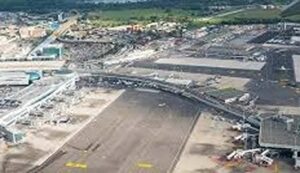Rome Airport’s ambitious expansion plan of Fiumicino is questionable
Lufthansa’s ability to carry out an ambitious expansion plan at Rome’s Fiumicino airport is a must for the German airline’s long-promised turnaround of Italy’s ITA Airways. Carsten Spohr, the CEO of Lufthansa, stated on October 1 that the airline would be helped to restructure by investing in additional international growth, which includes the agreed-upon purchase of a 41% stake in Alitalia’s successor, ITA. The airline is currently facing significant challenges due to high costs and prolonged delays in Boeing plane deliveries.

However, ITA’s future is directly linked to that of Rome’s primary airport. The construction of a third terminal and more runway space would enable Fiumicino to increase its capacity to 100 million people yearly, but this project is currently awaiting approval from the Italian airport authority ENAC.
“The excellence of Fiumicino was one of the factors that further encouraged us to invest in ITA Airways. In terms of runways and terminal capacity, it is one of the few airports in Europe with room to develop,” stated Spohr in July. The airport serves as a gateway to both Africa and Latin America.
Aeroporti di Roma (ADR) is owned by Mundys, an infrastructure corporation that is backed by Blackstone, an investing firm, and the Italian Benetton family. An eight billion euro development plan for Fiumicino was presented by the airport management in 2021 to ENAC, which is now reviewing it.
Lufthansa’s emphasis on Fiumicino, however, is being questioned by certain industry analysts: “They have identified Rome as a hub for Latin America.” However, Ruxandra Haradau-Doser of HSBC said, “ITA is not as well-positioned as (Portugal’s) TAP or (Spain’s) Air Europa.
When Reuters contacted ENAC for comment on the approval procedure, they did not reply, and ADR refused to comment on the same matter.
According to a Lufthansa representative, the northern Italian region of Milan’s catchment area and the Roman airport’s prosperity were both critical to ITA’s success.
AVAILABLE ITA
Given Lufthansa’s challenges in expanding its other hubs, Federico Maria Alberto Caligaris, an equity partner at consulting company CDI Global, believes it makes sense to concentrate on Fiumicino.
The CEO of TRA Consulting, a transport advice business, Andrea Giuricin, forecasted that the airport, which handled over 40 million passengers in 2023, would surpass 50 million the following year and continue to expand due to a robust influx of tourists and intercontinental travelers to Italy’s capital.
The airport’s lean economic strategy is particularly appealing; according to Reuters estimates, operational expenditures last year represented 60% of revenue, compared to around 74% in Frankfurt.
According to Giuricin, a carrier’s expense per passenger when a medium-range aircraft lands at a major European airport is anywhere from thirty to ninety percent more than at Fiumicino.
“On intercontinental flights, Fiumicino is also cheaper: Frankfurt costs almost double, and in general the fees are between 35 percent and 75 percent higher,” he said.
Fiumicino, which offers visitors the opportunity to see Roman sculptures and paintings in a hallway that leads to a new boarding area set to open in 2022, was named Europe’s greatest airport by the Airports Council International last year.
Travelers believe that more might be done to strengthen rail links with Rome, which is around 30 km distant, and to extend it.
While strolling past the Temple of Hadrian in the heart of Rome, Brazilian traveler Felipe Paiva said, “The airport is good and beautiful, but I’d expect a bigger one for a city like Rome.” “And transport to the city can definitely be improved.”
UNCERTAINTIES
Lufthansa’s gamble on ITA, whose predecessor Alitalia underwent several bankruptcys, became more complex due to its inability to oversee Fiumicino’s development.
The German airline was forced to issue two profit warnings this year due to skyrocketing labor costs, and investors and experts cautioned that Spohr’s ITA investment was not a panacea.
“At first glance, the plan seems reasonable and feasible, but there are implementation risks,” said Ingo Speich, head of corporate investment and sustainability at Deka Investment, the company that holds shares in Lufthansa.
Additionally, some experts emphasize that while Rome serves as a hub for incoming leisure travelers, core business travelers may not find the capital to be the most convenient location.
According to aviation researcher James Halstead, Italy’s primary airport hub “should really be in Milan, which is where the money is, where the power is, but it’s not where the politics are.”
A source inside Prime Minister Giorgia Meloni’s administration, who wished to remain anonymous, told Reuters that the right-wing coalition was in favor of more expansion at Fiumicino.
The major airport serving Milan, Malpensa, was said to have a very diverse airline portfolio and would continue to play a role even if Ficino grew, but its close proximity to Frankfurt and Munich, the primary German hubs of Lufthansa, might potentially pose a threat in the future.
“Rome is not actually a very good hub for the rest of Europe,” Halstead said. “There may be some opportunities down into South America because of the appeal to the Italian diaspora in Argentina and Brazil, but it’s a bit out of the way to attract traffic.”





